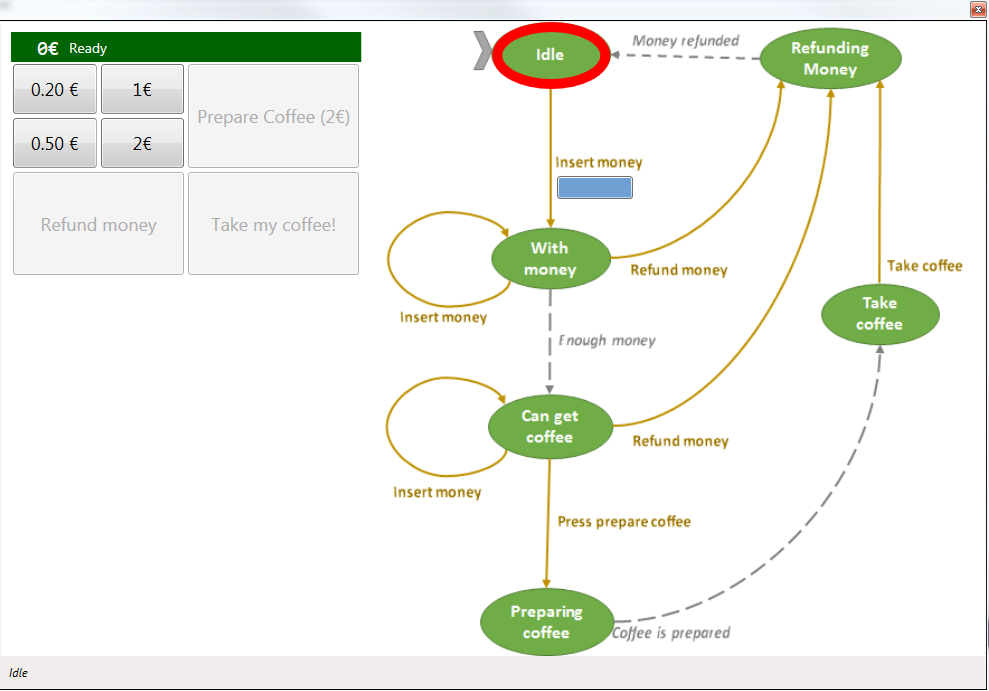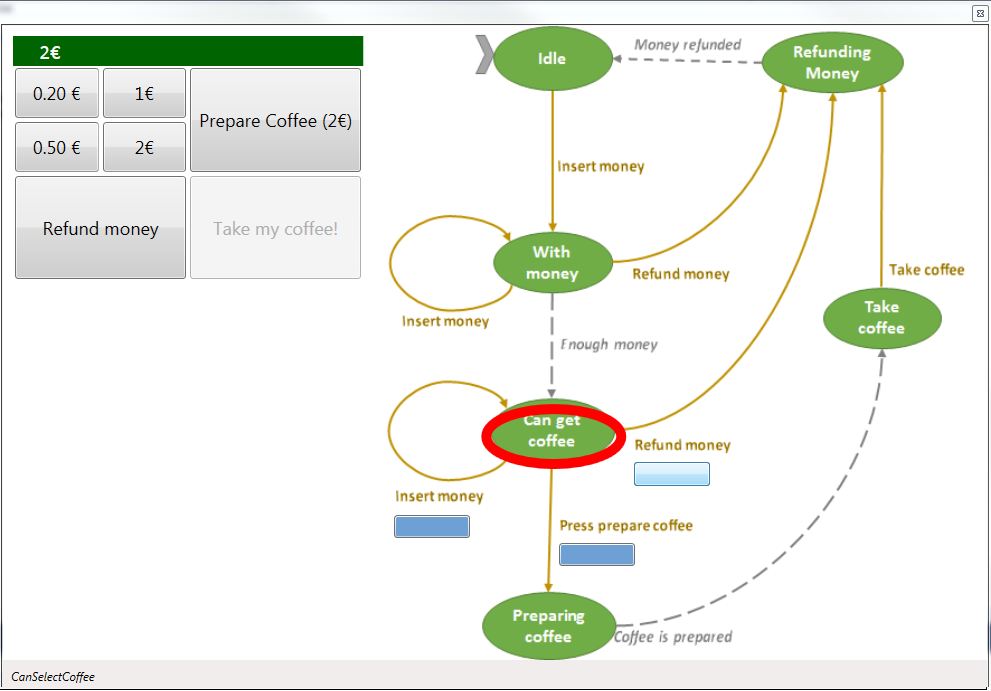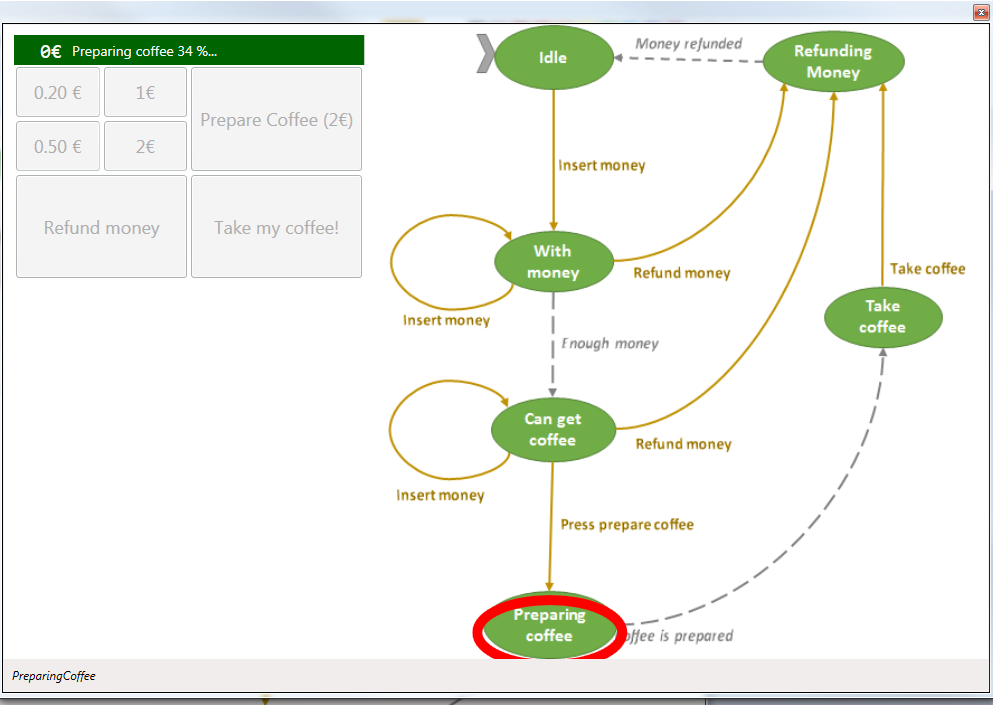The goal of this post is to test the usage of MVVM Delegate commands together with a state machine. You can read more about the state machine pattern here, and about commands here.
WPF allows to bind a command to some controls, the ICommand interface has two methods: one that executes an action and one that returns a Boolean indicating if the command can be executed or not.
E.g. Command bound to a button: When the button is clicked the action defined within the command is executed, when the command cannot be executed the button is disabled.
This is the ICommand interface.
public interface ICommand {
event EventHandler CanExecuteChanged;
bool CanExecute(object parameter);
void Execute(object parameter);
}
I will use the Microsoft PRISM 5 Delegate ICommand implementation and the stateless state machine.
ICommand + State Machine Trigger
On a state machine there are states and triggers, within one state some triggers are forbidden and other are allowed, when a trigger is fired the state machine could change its state.
Our commands shall be associated to a trigger, the behaviour should be:
- CanExecute: Shall return true only if the associated trigger can be fired on the current state.
- Execute: Shall fire the associated trigger, the machine could change its state.
The coffee machine
The application that we will write will be a very simple coffee machine with only one type of coffee:
States
- Idle: Machine waiting to be used.
- With money: The user entered some money but is not enough to get a coffee.
- Can get coffee: The user entered enough money to get a coffee.
- Preparing coffee: The coffee is being prepared.
- Coffee ready: The user can take the coffee.
- Refunding money: The machine is returning the money to the user.
Triggers
- Insert money: Fired when the user insert money.
- Refund money: Fired when the user press the refund money button and after the user takes the coffee.
- Enough money: Automatically fired when the user inserted enough money.
- Prepare coffee: Fired when the user select a coffee, (our machine is that simple that has only one…)
- Coffee prepared: Automatically fired when the coffee is prepared.
- Take coffee: Fired when the user takes the coffee.
- Money refunded: Automatically fired when the machine refunded the money.
The diagram
Implementation
States
public enum CoffeeMachineState
{
Idle,
WithMoney,
CanSelectCoffee,
PreparingCoffee,
CoffeeReady,
RefundMoney
}
Triggers
public enum CoffeeMachineTrigger
{
InsertMoney,
RefundMoney,
PrepareCoffee,
TakeCoffe,
// Automatic triggers
EnoughMoney,
CoffeePrepared,
MoneyRefunded
}
Configuration
/// <summary>
/// Configures the machine.
/// </summary>
private void ConfigureMachine()
{
// Idle
this.Configure(CoffeeMachineState.Idle)
.Permit(CoffeeMachineTrigger.InsertMoney, CoffeeMachineState.WithMoney);
// Refund money
this.Configure(CoffeeMachineState.RefundMoney)
.OnEntry(RefundMoney)
.Permit(CoffeeMachineTrigger.MoneyRefunded, CoffeeMachineState.Idle);
// WithMoney
this.Configure(CoffeeMachineState.WithMoney)
.PermitReentry(CoffeeMachineTrigger.InsertMoney)
.Permit(CoffeeMachineTrigger.RefundMoney, CoffeeMachineState.RefundMoney)
.Permit(CoffeeMachineTrigger.EnoughMoney, CoffeeMachineState.CanSelectCoffee);
// CanSelectCoffee
this.Configure(CoffeeMachineState.CanSelectCoffee)
.PermitReentry(CoffeeMachineTrigger.InsertMoney)
.Permit(CoffeeMachineTrigger.RefundMoney, CoffeeMachineState.RefundMoney)
.Permit(CoffeeMachineTrigger.PrepareCoffee, CoffeeMachineState.PreparingCoffee);
// PreparingCoffee
this.Configure(CoffeeMachineState.PreparingCoffee)
.OnEntry(PrepareCoffee)
.Permit(CoffeeMachineTrigger.CoffeePrepared, CoffeeMachineState.CoffeeReady);
// CoffeeReady
this.Configure(CoffeeMachineState.CoffeeReady)
.Permit(CoffeeMachineTrigger.TakeCoffe, CoffeeMachineState.RefundMoney);
this.OnTransitioned(NotifyStateChanged);
}
StateMachine command factory
The factory will create commands associated to a trigger, the command will fire the trigger when it is executed and can only executed only if the trigger can be fired on the current state.
The factory also support to add an additional action to execute when the trigger is fired and an additional function to evaluate the “CanExecute” result.
using System;
using Microsoft.Practices.Prism.Commands;
using Stateless;
namespace CoffeeMachine.Wpf.Comands
{
public static class StateMachineCommandEx
{
/// <summary>
/// Creates a DelegateCommand using a trigger and a state machine.
/// The command can be executed if the trigger can be executed on the current state machine status and the specified "CanExecute" function is null or returns true.
/// When the command is executed the specified action is executed and then the trigger is fired
/// </summary>
/// <typeparam name="TState">State machine status type.</typeparam>
/// <typeparam name="TTrigger">State machine status trigger.</typeparam>
/// <param name="stateMachine">A state machine instance</param>
/// <param name="trigger">A trigger.</param>
/// <param name="execute">Action to execute when the command is executed.</param>
/// <param name="canExecute">The command can be executed only if this function is null or return true and the current status of the machine supports the trigger.</param>
public static DelegateCommand CreateCommand<TState, TTrigger>(this StateMachine<TState, TTrigger> stateMachine, TTrigger trigger, Action execute = null, Func<bool> canExecute = null)
{
if (canExecute == null)
{
canExecute = () => true;
}
if (execute == null)
{
execute = delegate { };
}
return new DelegateCommand(
executeMethod: delegate
{
execute();
stateMachine.Fire(trigger);
},
canExecuteMethod: () => stateMachine.CanFire(trigger) && canExecute());
}
/// <summary>
/// Creates a DelegateCommand using a trigger and a state machine.
/// The command can be executed if the trigger can be executed on the current state machine status and the specified "CanExecute" function is null or returns true.
/// When the command is executed the specified action is executed and then the trigger is fired
/// </summary>
/// <typeparam name="TState">State machine status type.</typeparam>
/// <typeparam name="TTrigger">State machine status trigger.</typeparam>
/// <typeparam name="TCommandParam">Command parameter type</typeparam>
/// <param name="stateMachine">A state machine instance</param>
/// <param name="trigger">A trigger.</param>
/// <param name="execute">Action to execute when the command is executed.</param>
/// <param name="canExecute">The command can be executed only if this function is null or return true and the current status of the machine supports the trigger.</param>
public static DelegateCommand<TCommandParam> CreateCommand<TState, TTrigger, TCommandParam>(this StateMachine<TState, TTrigger> stateMachine, TTrigger trigger, Action<TCommandParam> execute = null, Func<bool> canExecute = null)
{
if (canExecute == null)
{
canExecute = () => true;
}
if (execute == null)
{
execute = delegate { };
}
return new DelegateCommand<TCommandParam>(
executeMethod: delegate(TCommandParam param)
{
execute(param);
stateMachine.Fire(trigger);
},
canExecuteMethod: arg => stateMachine.CanFire(trigger) && canExecute());
}
}
}
Sample of usage:
// Initializes a new instance of the &amp;lt;see cref=&amp;quot;ShellViewModel&amp;quot;/&amp;gt; class.
public CoffeeMachineViewModel()
{
this.CoffeeMachine = new CoffeeMachineModel();
// Create commands
InsertCoinCommand = CoffeeMachine.CreateCommand&amp;lt;CoffeeMachineState, CoffeeMachineTrigger, double?&amp;gt;(
trigger: CoffeeMachineTrigger.InsertMoney,
execute: param =&amp;gt; this.CoffeeMachine.InsertCoin(param ?? 0));
RefundMoneyCommand = CoffeeMachine.CreateCommand(CoffeeMachineTrigger.RefundMoney);
PrepareCoffeeCommand = CoffeeMachine.CreateCommand(CoffeeMachineTrigger.PrepareCoffee);
TakeCoffeeCommand = CoffeeMachine.CreateCommand(CoffeeMachineTrigger.TakeCoffe);
}
Results (Sorry for the ugly UI):
Idle state screenshot
Can get coffee state screenshot
Preparing coffee state screenshot
Reference:





Your feedback is important…